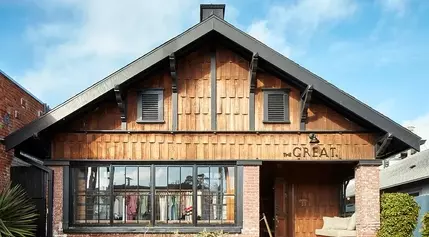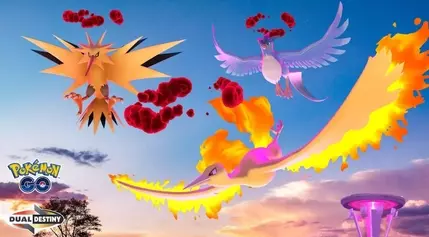An easy-care evergreen shrub, Japanese skimmia (Skimmia japonica) makes a great groundcover or hedge, depending on the variety. Dark green, glossy leaves decorate this slow-growing, shade-loving shrub year-round. Plant a low-growing dwarf variety near an entryway or patio to create interest and structure all year. Plant several 5- to 7-foot-tall varieties of Japanese skimmia together to create a living screen. Tolerant of poor soil and dry conditions, Japanese skimmia can thrive in tough planting locations, but it grows best in shade and rich, acidic, well-drained soil.
Japanese skimmia is available in labeled male and female cultivars. Both cultivars have spring flowers, but the male cultivars tend to have larger, more fragrant flowers. Enjoy the fragrance by planting it near a walkway or patio. Female plants produce red berries in fall when a male plant is present. Count on the bright red berries to decorate the plant through winter.
The berries of Japanese skimmia shrubs are toxic to humans when ingested. Be cautious planting them around kids' play areas.
Japanese Skimmia Overview
| Genus Name | Skimmia |
| Common Name | Japanese Skimmia |
| Plant Type | Shrub |
| Light | Part Sun, Shade |
| Height | 1 to 7 feet |
| Width | 4 to 6 feet |
| Flower Color | White |
| Foliage Color | Blue/Green |
| Special Features | Fragrance, Low Maintenance |
| Zones | 6, 7, 8, 9 |
| Propagation | Stem Cuttings |
Where to Plant Japanese Skimmia
Japanese skimmia is a problem-solver plant for shade landscapes. It thrives in low light, growing best in part shade or full shade. Use it as a foundation plant on the shady north or east side of a home. Employ it as a groundcover under large trees. Use large cultivars to create an evergreen hedge under a dense tree canopy. Japanese skimmia grows well in containers. Plant it in a large container and enjoy its rich green leaves year-round.
Japanese skimmia doesn’t tolerate wet or boggy soil. Plant it in well-drained soil that is rich and acidic. It will tolerate periods of drought and lean soil. Hardy in Zones 6 through 9, Japanese skimmia thrives in dry climates.
How and When to Plant Japanese Skimmia
Plant Japanese skimmia in early spring or fall. When shopping for plants, pay close attention to the mature size of the cultivar. Some Japanese skimmia cultivars grow just 2 feet tall and spread to make a woody groundcover in a shrub bed or foundation planting. Other cultivars top out at 5 to 7 feet tall and are medium-sized shrubs.
To plant Japanese skimmia, dig a hole a couple of inches wider than the rootball. The hole should be as deep as the rootball; ensure the top of the rootball aligns with the surrounding soil surface. Place the plant in the hole and backfill it with native soil. Form a shallow basin around the base of the plant and cover the soil surface with a 2-inch layer of mulch. Water the newly planted shrub weekly, moistening the soil to 6 inches below the surface for the first two months, and then water as needed.
Japanese Skimmia Care Tips
Light
Japanese skimmia grows best in part shade or full shade. It thrives in the dappled sunlight of an overhead canopy and grows well in deep shade too. It tolerates up to six hours of morning sunlight a day. It does not grow well in locations with prolonged afternoon sun exposure. Intense afternoon sunlight and heat will scorch Japanese skimmia foliage.
Soil and Water
Well-drained, acidic soil that is rich in organic matter is best for Japanese skimmia. Avoid planting locations with boggy soil or sites with slow-draining clay. Established plants tolerate dry spells with ease. Aim to provide plants with about 1/2-inch of water per week. Prevent soil moisture evaporation by spreading a 2-inch-thick layer of mulch over the root zone.
Temperature and Humidity
Hardy in Zones 7-9, with a few cultivars hardy in Zone 6, Japanese skimmia does not tolerate intense cold weather. Protect vulnerable plants from winter damage by spreading a thick layer of mulch over the root zone and erecting a burlap barrier around the plant to prevent damage from drying winter winds.
Fertilizer
Japanese skimmia does not require fertilization. These resourceful plants obtain the nutrients needed for good growth from the native soil.
Pruning
Prune Japanese skimmia as needed in early spring. These slow-growing plants rarely require pruning. Prune to remove broken and damaged branches. Prune away diseased branches, making the pruning cut well below the diseased portion of the plant.
Potting and Repotting
Japanese skimmia shrubs are excellent container plants. Plant one shrub in a pot at the same level the plant was in its nursery container, making sure the soil is rich, well-draining and slightly acidic. Choose one of the dwarf cultivars of Japanese skimmia for an easy-to-move container, or use a container on wheels. These shrubs are slow-growing and are unlikely to need repotting for years. When they do, select a slightly larger container and fill it with fresh potting medium.
Pests and Problems
No serious pests or problems affect Japanese skimmia. In arid environments, spider mites can be a problem; they disfigure the foliage. A blast of water may reduce the population or they can be treated with insecticidal soap or neem oil. Occasionally, scale and aphids are troublesome.
How to Propagate Japanese Skimmia
Make more Japanese skimmia plants by taking 6- to 8-inch stem cuttings of tender new growth in late summer. Remove the foliage from the lower half of the cutting. Dip the bottom of the cutting in rooting hormone and insert it into moist potting media that is slightly acidic. Water cuttings regularly and keep them in a frost-free location over the winter.
Types of Japanese Skimmia
Many varieties of Japanese skimmia are available in Europe, but only a few are available in commerce in North America. With the increasing popularity of Japanese skimmia, expect more varieties to emerge soon.
'Bronze Knight'
Skimmia japonica ‘Bronze Knight’ has foliage that turns bronze in winter. This shrub has dark red flower buds that open to dense white flowers. It is a male cultivar that doesn’t produce berries. It grows about 3 feet tall and wide.
'Bowles Dwarf Female'
Skimmia japonica ‘Bowles Dwarf Female’ grows 1 to 1.5 feet tall and wide and has a compact round form. It produces berries when planted with a male cultivar.
'Bowles Dwarf Male'
Skimmia japonica ‘Bowles Dwarf Male’ grows 1 to 1.5 feet tall and wide and has a compact round form and no fruit. Expect it to have fragrant white flowers.
'Magic Marlot'
Skimmia japonica ‘Magic Marlot’ is a male cultivar that grows 1.5 to 3 feet tall and has striking green leaves with creamy white margins. Its flower buds appear red before opening to white flowers.
Japanese Skimmia Companion Plants
Grow Japanese skimmia with other shade-loving shrubs to create a lush landscape that is rich in texture.
Camellia
The blooms of camellia come in shades of pink, red, and white that enliven the garden in the spring, fall, or even winter in mild climates. Camellias with small flowers tend to be the best choices for fragrance because breeding efforts for large formal types focus on size rather than scent. These shrubs come in six bloom types: single, semi-double, anemone, peony, rose-form double, and formal double. Each form features a specific petal arrangement and number of petals.
Lily-of-the-Valley Shrub
Commonly known as lily-of-the-valley shrub, this broadleaf, evergreen shrub is also occasionally called andromeda or Japanese pieris. Its common name comes from the flowers it produces, which closely resemble those of the perennial lily of the valley. Although it isn't as fragrant as its groundcover look-alike, the lily-of-the-valley shrub has a sweet, light scent. This early bloomer grows best in partial shade and produces clusters of flowers in late winter or early spring.
Rhododendron
A classic shade garden plant, rhododendrons bring glossy green foliage and showy clusters of blooms to the garden. Available in a variety of hues, the most common flower colors are purple, pink, white, and cream. The Rhododendron genus contains an option for every landscape, from the giant rhododendrons of East Asian mountainsides to the rosebay rhododendrons native to Eastern U.S. woodlands.




















